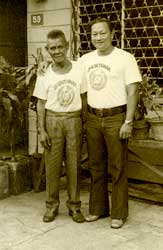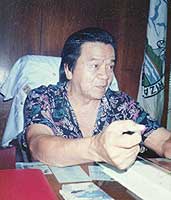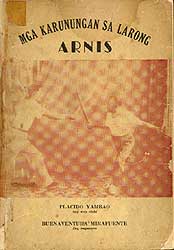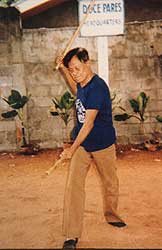20th-Century Arnis
The Reemergence of a Warrior's Art
By Mark V. Wiley
Filipino martial arts have existed, been suppressed, and reemerged as a subculture within Philippine society for centuries. For over three hundred years, practice of the arts was outlawed by the Spanish colonizers. However, the popularity of the arts of arnis and eskrima began to resurface on the island of Cebu during the 1920s, whereon a number of martial art practitioners began to openly teach their arts.
In 1920 the late Venancio "Anciong" Bacon, the founder of Balintawak arnis, opened the Labangon Fencing Club-the first commercial arnis club in Cebu. Following Bacon's, lead Johnny Chiuten,
It wasn't until the 1930s, however, that the various masters in Cebu and the neighboring islands came together in the interest of perpetuating the Filipino martial arts. As a result the famed Doce Pares Association was organized in 1932. The Doce Pares Association is the oldest and longest standing martial arts organization in the Philippines and was a driving force behind the reemergence of Filipino martial arts into Filipino society.
In 1939, Doce Pares was joined by the six Cañete brothers. With differences in political view, Bacon left and founded the Balintawak Self-Defense Club.
Eulogio "Yoling" Cañete became the new Doce Pares president.
In 1937, Benjamin Luna Lema founded the Lightning Arnis Club in Mambusao, Capiz.
Ten years later, in 1947, he was requested by the United States Air Force to relocate to Agana, Guam, to instruct their enlisted men in hand-to-hand combat and arnis. The 1940s also saw the development of the infamous Filipino butterfly knife known as the balisong. In a town in Batangas now known as Barrio Balisong, Perfecto de Leon is credited with developing and manufacturing the first balisong knife. Since that time the balisong has become perhaps the most infamous Filipino weapon.

Amador "Mading" Chavez was one disciple who was fortunate to have learned all of the twelve styles. After the Bacolod Arnis Club dissolved, Chavez founded the Chavez Arnis Group in 1959. 1957 saw the publication of Placido Yambao's book, Mga Karunungan sa Larung Arnis (Knowledge in the Art of Arnis).

During the decade of the 1960s Filipino martial arts again felt a resurgence of interest with schools and styles opening themselves up to the public. In Manila this revival was initiated by an organization called Samahan sa Arnis ng Pilipinas (Association of Arnis in the Philippines). In his speech during the launching of the revival of arnis in Manila, Former Secretary of Philippine Education, Alejandro Roces praised members of the Association, stating:
"A neglected aspect of our cultural history as a people, arnis is as old as the Philippines. It is germane to the Filipino, his culture and temperament. During the prehistoric times, it was indulged in as a form of recreation. Filipinos learned it together with reading, writing, religion, incantation, and Sanskrit. It was not, at that time, merely fencing, as we now regard that term. It had its variations in the form of dance and combative arts known as sayaw or sinulog, which was both artistic and entertaining."
Mark V. Wiley
Mark began martial arts training in 1979 and the study of mind-body health practices in 1987. Since 1994, Wiley has been conducting extensive research on martial arts and healing traditions in the Philippines, Malaysia, Singapore, Taiwan, Japan, Hong Kong, and the United States. During that time, he lived in Japan and the Philippines. 1990 saw the publication of his first article in Black Belt Magazine, and he has since published over 400 more. In 1994 his first book was published, in 1995 he joined the editorial board of the Journal of Asian Martial Arts, and in 1996 he became the martial arts Editor for Tuttle Publishing in Tokyo, Japan. In 2000, Mark was the first person to conduct martial art research among the MatigSalog tribe of Mindanao, Philippines. Some of his senior ranks, titles, and awards include:
Master's Degree in Cabales Serrada Escrima, awarded by Grandmaster Angel Cabales (1990) – 7th Degree Black Belt in Modern Arnis, awarded by Grandmaster Remy Presas (2001) – Associate Grandmaster of FMA and 6th Dan Master ofKabaroan Eskrima, awarded by Grandmaster Ramiro Estalilla (2005) – Honorary Grandmaster of Serrada Escrima, awarded by the World Serrada Escrima Federation (2013) – Lakan Sampu (10th Dan), awarded by Grandmaster Vicente Sanchez (2013) – Datu and Grandmaster, awarded by the Modern Lightning Kali Arnis de Abaniko FMA Association (2013) – Recognized as 'Publisher of the Year' by the United Fellowship of Martial Artists (2015) – Named "FMA Ambassador" by iArnis, Philippine Sports Commission, Philippine Olympic Committee, Philippine Department of Tourism, Philippine National Commission for Culture and Arts(2015) – Master of Ngo Cho Kun (2015) and Head of Beng Hong Athletic Association (1998), awarded by Sifu Alexander Lim Co – Inducted into the Philadelphia Historic Martial Arts Society Hall of Fame (2016) – Faculty Member of the Global Fellowship of FMA Legends and Grandmasters (2016) – Named as an Adviser to the Mataw Guro Association, by MG Louelle Lledo (2016) – Board of Advisers and Medical Consultant to the Society of Black Belts of America, by Shihan Christopher Viggiano (2017) – Board of Directors of the Arnis Pederasyon International, Inc., awarded by GM Reymond Velayo and Datu Shishir Inocalla(2017) – Recognized as "Holistic Healer and Martial Arts Historian" at the Legacy of Mosses Powell (2018).
Within the Filipino martial arts, Wiley was a direct student and disciple of seven FMA grandmasters, Remy Presas, Angel Cabales, Herminio Binas, Florendo Visitacion, Ramiro Estalilla, Benjamin Luna Lema, and Antonio Ilustrisimo. Wiley is the developer of Integrated Eskrima, a cutting-edge system of teaching and training Filipino martial arts. Within Chinese martial arts, he is the disciple of Sifu Alexander Lim Co and as the head of Beng Hong Athletic Association, one of the standard bearers of Ngo Cho Kun (Fujian Five Ancestor Boxing), and Instructor of Wing Chununder Sifu Robert Chu. He is also a student of Pak Mei, Jook Lum and Chu Gar.
Mark is a prolific author on the topics of Filipino and Chinese martial arts and natural wellness. His martial arts books include: Filipino Martial Arts: Cabales Serrada Escrima, Filipino Martial Culture, Martial Arts Talk, Arnis: Reflections on the History and Culture of Filipino Martial Arts, Secrets of Phoenix Eye Fist Kung-Fu, Mastering Eskrima Disarms, Secrets of Cabales Serrada Escrima, Filipino Fighting Arts: Theory and Practice. His health books include: The Hypertension Solution, Outwitting Headaches, Headaches Relieved, Natural Solutions for Pain and Inflammation, Arthritis Reversed.
He has written chapters for the Illustrated Encyclopedia of Body-Mind Disciplines, the Encyclopedia of World Sport, Indo-Malay Martial Traditions, Asian Martial Arts, Monks, and Ways of Thought: An Anthology, Filipino Martial Arts Anthology, in addition to penning forwards to over 20 books, and has been profiled in the The Martial Arts Directory, The World's Greatest Martial Artists, and Escrima Masters. He has served as executive martial arts editor for Tuttle Publishing, in their Tokyo and Boston offices, as publishing manager for Multi-Media Books and Unique Publications, as associate publisher of Martial Arts Illustrated magazine, editor of Martial Arts Legends magazine and Quality of Life, and as associate editor of the Journal of Asian Martial Arts. Wiley has been featured on the cover of six magazines and inducted into several Hall of Fames. In 2013 he founded Tambuli Media, and since 2018 has been involved in film writing and production, including his award-winning feature film, Made in Chinatown.
Search for more articles by this author:








